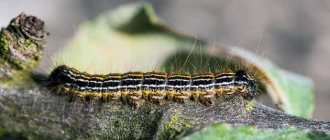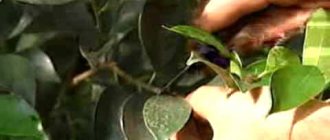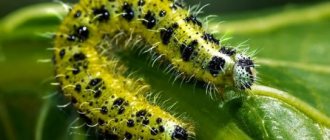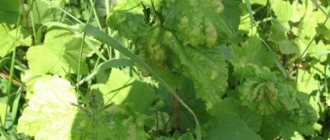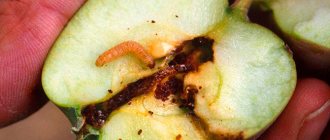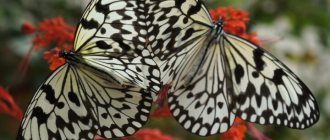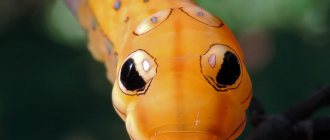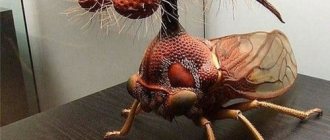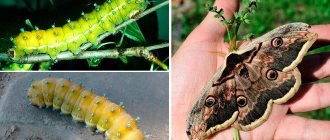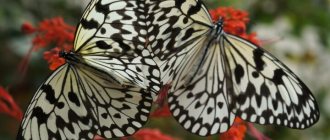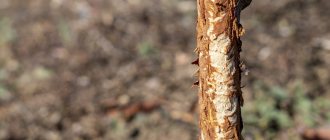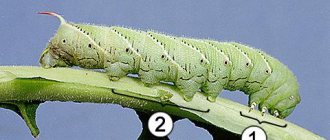If caterpillars on a gooseberry have eaten the leaves, how to deal with them is an urgent question, since the plant needs to be saved. There are several pests that are very fond of this fruit crop. For this purpose, you can use chemicals, as well as numerous folk remedies.
Caterpillars on gooseberries: briefly about the beginning of activity
Caterpillars on gooseberries: photo
In spring, not only trees, herbs and shrubs bloom and grow, but also harmful insects awaken from sleep, which can greatly damage your plants or even destroy them. Insects love to eat gooseberry leaves, most often caterpillar larvae do this. It is very important to carry out prevention against various pests.
Preventive measures
At the end of autumn, all plant debris is raked into a heap and destroyed. The earth is loosened. If there have been a lot of pests this season, the top layer of soil (about 10 cm) is replaced with a new one.
To prevent insects that remained in the soil for the winter from getting to the surface and harming the plant in the spring, the tree trunk circle is covered in the fall with dense black agrofibre . Immediately after the snow melts, the soil is spilled with boiling water, which will destroy the larvae of pests that escaped death from frost.
Immediately after this, dry, old and diseased branches are removed, and the sections are sprinkled with wood ash. Loosening the soil is carried out after each watering. Even tiny weed sprouts are removed. The tree trunk circle is mulched with straw or humus.
Important! In a well-kept garden, plants suffer less from pests and diseases.
Who eats gooseberries?
Caterpillars on gooseberries: photo
Most often, your plantings are spoiled by caterpillars; they love to devour plant leaves. There is more than one type of caterpillar larvae. Because there are different species, there are different ways to combat them.
- The gooseberry moth is a green larva that spoils the harvest, about a couple of centimeters long - the gooseberry moth.
- Gooseberry sawfly . Another leaf eater is the gooseberry sawfly, usually with blue and green tints and dark spots.
- Gooseberry aphids are small green larvae, the larvae slow down the growth of plants, the leaves begin to change shape and curl.
- Spider mite. A very small insect, both in adult and small form, the spider mite, can only be seen with special devices and causes the death of leaves.
Shoot aphid
Shoot aphids on gooseberries
are a common type of pest. Her eggs remain on the shoots in winter. With the onset of spring, larvae appear and feed on the sap of young leaves. As soon as insects fly out of them, they settle on the top of young shoots, slowing down their growth. The leaves become deformed, resulting in a lump of them forming at the tops. Thus, the aphid creates a “house for living” for itself. Gooseberries affected by aphids grow poorly and buds appear late.
Caterpillars on gooseberries: sawflies on gooseberry shoots
Caterpillar on gooseberries: photo
Usually the most difficult insect to breed is the sawfly caterpillar. Often gardeners encounter complete destruction of leaves by this species. Also, this type of pest often likes to destroy various types of currants.
Yellow and pale-legged caterpillars are the most common sawfly caterpillar species.
Both varieties eat leaves often to a minimum; even the pathetic ones can often be eaten. Similar to ordinary caterpillars. Color varies from green to slightly blue. They have twenty legs. The caterpillars have dark spots over the entire surface area.
They survive the winter as insects and larvae near the main stem of plants in the ground. Fourteen centimeters underground, caterpillars overwinter in thick cocoons. With the onset of the first warming, the larvae acquire cocoons; during the beginning of the flowering periods of the plant to attack, the cocoons turn into adult insects.
When fresh leaves begin to form, females begin laying eggs on their undersides. After a fairly short time, the pests hatch and begin to grow very rapidly. First, small holes appear on the leaves, which over time completely absorb the entire leaf. On average, caterpillars live twenty-five to thirty days, from the cocoon stage to the adult stage. Then the insect descends to the ground, enters the cocoon stage, and everything repeats all over again.
Due to the fact that the larvae are microscopic in size, it is impossible to see them without special instruments. Of course, when they start to grow, minimal holes appear on the leaves, but these are usually overlooked.
Attention! If you understand that the number of individuals of this species is very large, then it may not be possible to save the plant and in the second week your plant, unfortunately, will die under their onslaught.
There are several serious negative consequences of an attack by these pests.
- The harvest becomes smaller and its quantity decreases. The berries fall off fairly quickly.
- Shoots are greatly slowed in growth. In winter, the bushes become less stable.
Currant borer
Currant borer primarily damages gooseberry branches. The larvae of this beetle eat away the core of the plant shoots, starting from the top and moving lower.
The yield of the bush drops sharply, and the berries remain small. In winter, the larvae of the borer are found inside the shoots and pupate there.
Young beetles begin to emerge from the shoots in late spring (May) - early summer (June). Approximately 8-10 days after this emergence, female beetles begin laying eggs on the bark of shoots, as well as on leaf petioles.
They cover the eggs with their secretions, which harden on the bark, forming a hard oval shield. Then, after 12-16 days, the larvae crawl out from under the shield and begin their dirty work.
Control measures include cutting and burning affected branches; correct and timely pruning of the bush; planting healthy seedlings.
Caterpillars on gooseberries: moths - green caterpillars
When you notice green caterpillars on a gooseberry, there is almost a 100% chance that these are moths. Moths are very harmful to gooseberries.
The average size is within one and a half centimeters. There are black stripes, the main color is green, quite rich. The head is black.
The pupae survive the winter in the upper layers of the soil. The pupae open and butterflies appear during the flowering period of the plants. Butterflies lay eggs in flowers at the end of flowering. There is an average of two hundred eggs, this is how many eggs one female lays on a plant. In just over a week, small individuals emerge from the eggs. Little caterpillars eat literally everything they can. The caterpillars live on the leaves for about a month; as a rule, the condition of the plant deteriorates greatly during this short period. Most often, nutrition comes from the fruits themselves and the seeds they contain. As the caterpillars consume each berry, they weave a web around it.
Pupation or transformation into a pupa occurs after a month of the caterpillar's life on the plant; pupae are often formed during berry picking.
There are several characteristic signs of an attack by moth caterpillars.
- The berries are “perforated” and there is a barely noticeable web stretched between the berries.
- When a cobweb coma is detected, you can see about six berries; there are both intact fruits and rotten fruits that are impossible to eat.
- When such lumps are opened, you can see the caterpillars themselves.
Caterpillars on gooseberries: glass
Most often this species appears on currants, but it is also very dangerous for gooseberries.
At the very beginning of the development and formation of these individuals, they are almost impossible to see. Because of this, the vast majority of gardeners begin to remove insects when the plants can no longer be saved. Currant glass beetles can eat all plants if they are not detected in time.
Adult females lay about six dozen eggs on the branches of the bush.
The larvae are white. The heads are black. They eat everything and very quickly. Harmful larvae hatch from eggs almost two weeks after they are laid. At this time, individuals are very vulnerable. The caterpillars are easy to kill as they feed on the leaves, then they move directly into the bushes and simply gnaw right through them. It turns out that the bushes are deprived of vitality from the inside. Insects also spend the winter inside plants and, as the weather gets warmer, emerge from their shelters to lay the next batch of eggs.
Signs of gooseberry attack by glassware
- If these caterpillars live on a branch, then as a rule there are fewer shoots on it than on a healthy one.
- In very hot weather, the leaves quickly wither and fall off.
- The plant dies when the glass cells have been living in it for the second year.
- If you cut off an attacked shoot, you can see a hole in its middle with the remains of insects.
Most often, it happens that the owner of the garden or the person who looks after it is to blame for caterpillar attacks.
Consequences of the appearance
The main purpose of the reproduction of insect pests on the surface of the bush is to provide themselves and their offspring with the food supply necessary for growth and development, therefore, often with mass development they lead to the complete or partial destruction of the green mass of plants.
We recommend that you read
Everything about gooseberries: description, properties, cultivation characteristics, wild species. It is the center of the photosynthetic apparatus, since the leaves contain specific cells that ensure the conversion of solar energy into chemical energy.
As a result, the plant is unable to fully maintain its vital functions and metabolism.
In addition, the foliage creates a special microclimate for the shoots, protecting them from intense sunlight.
In case of complete loss of leaves, this can lead to the death of a valuable fruit crop from lack of nutrition or drying out of the shoots.
If the parasite did not manage to completely destroy the leaves, such a plant will remain viable, but its productivity and development activity will be suppressed. In addition, the gooseberry's immunity will also be suppressed, and in some cases, in addition to parasitic infestation, this can cause an infectious disease caused by all kinds of viruses, bacteria or fungi.
What caterpillars eat gooseberry leaves
The following insects are considered to be the most dangerous for gooseberry leaves and other fruit bushes:
- Shoot aphid - as the insect develops, it feeds on the sap of the leaves, which gradually causes them to curl. This leads to the formation of lumps of green plant matter in which aphids multiply en masse. If the pest is not eliminated in a timely manner, the insect causes the bush to slowly wither.
- Yellow sawfly - after hatching, the parasites intensively feed on the green mass of the gooseberry, in just a couple of days this leads to the complete disappearance of the leaves on the bush.
- Moth - caterpillars parasitize twice a season: the first time they are able to completely consume all the green mass of plants in early spring, and then in August. Thus, bushes can grow with leaf pathologies throughout the entire growing season.
- Leaf roller - this parasite feeds on the sap and green mass of bushes, entwining them with a cobwebby coating. Such a lesion is observed twice per season: in the spring and during the ripening period of the berries. This causes not only oppression of the gooseberry and curling of the green mass, but also a deterioration in the quality of its fruits.
In addition, bushes can be affected by less dangerous pests that are not capable of causing mass death of leaves, but have a negative impact on fruiting and development of gooseberries. These include spider mites, gall midges, leaf beetles, glass beetles and gold beetles.
How to treat gooseberries against caterpillars? Folk remedies
- Next to the gooseberries you can plant an odorous plant - red elderberry, it can repel caterpillars.
- It is possible to pollinate plants with an elderberry solution: two hundred grams of ground flowers and shoots are diluted in ten liters of hot water. The mixture needs to sit for about two hours and can be used. The solution can be sprayed on the plant during flowering and after it to destroy the caterpillars.
- Fumigation can be done using tobacco dust. On the leeward side, collect a “mountain” of dry garbage, and place a couple of kilograms of tobacco dust on the top. Fumigation should last approximately half an hour.
- You can sprinkle the ground near the bushes with a mixture: one tablespoon of ground mustard, a cut glass of tobacco dust and three hundred grams of wood ash.
- You can spray the plants with a solution of one hundred grams of young spruce cones filled with heated liquid. The solution is infused for five hours and the plants can be sprayed. Treatment will be needed once a week during the entire flowering period.
- All home remedies work well if they are repeated regularly, loosened the soil near the plants, carry out sanitary pruning and collect spoiled fruits.
Control methods, rules of application
After the first signs of a pest appearing on the site, effective control against parasitic insects should be immediately launched. For this, there are a lot of various means, as well as methods that are not inferior in effectiveness to one another. At the same time, they are usually divided into traditional (based on chemical solutions) and folk (prepared from improvised means).
Chemicals
Chemical protection products have been actively used in agronomy for many years. They give instant results and are capable of destroying parasites even in the case of massive development. However, only a certain group of substances can be considered safe for crops and the environment.
We advise you to pay attention to the principle of using the Topaz fungicide for gooseberries.
"Inta-Vir"
This product refers to contact chemicals that affect the intestinal and nervous systems of insects. Due to this, within a few hours after application, the caterpillars lose the ability to eat food and die a day after treatment.
“Inta-Vir” is widely used for all kinds of gooseberry pests and has a lethal effect on 52 types of parasites, but the product best helps cope with aphids and glass beetles.
The working solution is prepared from 1 tablet of the product and 10 liters of water. The resulting liquid is used to treat the shoots and leaves of the bush at a rate of 2 l/bush. Plants need to be sprayed twice. The first time this is done before flowering begins, the second treatment is carried out within a week after harvesting.
"Decis"
The drug "Decis" enters the body of pests through the intestinal route. A few hours after the defeat, it provokes a blockade of the nervous system, which leads to disruption of the activity of the entire organism as a whole. The end result is the gradual death of insects.
The effectiveness of the drug against all kinds of pests is extremely high and is approximately 8 points out of 10 possible. Prepare a solution for spraying from 1 g of concentrate and 10 liters of water. Depending on the size of the bush, the consumption of working fluid is 10 l/2–5 plants. The plantings should be treated twice, with an interval of 14–20 days, but no later than 30 days before harvesting the berries.
Important! In some cases, “Decis” can cause burns to young shoots, so spray it on 1
–
2-year-old seedlings with special care.
"Kinmiks"
The main purpose of using Kinmiks is to combat the development of small sucking parasites on fruit and ornamental crops. The product affects insects through the intestinal contact method, causing paralysis of the nervous system with subsequent death. The product is used against a wide range of parasites, but it best protects against aphids and sawflies.
To prepare the mixture for spraying, dissolve one ampoule of concentrate in a liter of water. The resulting liquid should be brought to 10 liters, and then used to treat leaves and shoots with a flow rate of 1–1.5 liters per bush. Plants can be treated throughout the growing season, but no more than 2 times, with an interval of 14 days. In this case, at least 3 weeks must pass from the last spraying to harvesting the berries.
"Iskra-M"
"Iskra-M" is used for a wide range of sucking and gnawing parasites of fruit and ornamental crops. The powerful contact effect of the drug helps to destroy most existing gooseberry pests for a long time, which will provide the plantings with excellent immunity for the entire season.
Prepare a treatment agent at the rate of 1 ml of concentrate/1 liter of water. The entire surface of the bush is thoroughly sprayed with the resulting mixture at a consumption of 1–1.5 l/bush. Such treatments are carried out throughout the entire growing season, twice, with an interval of 20 days, but no less than 20–30 days before harvesting the berries.
"Fitoverm"
This insecticide is intended to combat any pests of fruit and ornamental plants, including indoor species. The drug is a derivative of waste products of fungi of the genus Streptomyces
and affects parasitic species in an intestinal-contact manner, causing a nerve-paralytic effect.
Prepare the product at the rate of 1 ml/1 liter of water; the resulting liquid is sprayed onto the bushes at a rate of 100 ml/1 m² of plantings. Such procedures are performed at least 2 times, until the insects and their larvae are completely destroyed, with a break of 14–20 days.
"Fufanon"
"Fufanon" is a complex insecticide that has a damaging effect on most types of gnawing and sucking parasites of fruit and ornamental crops. The drug enters the body through contact, causing all kinds of nerve damage to the body and the death of parasites.
To prepare a mixture for spraying plants, you need to dissolve 10 ml of concentrate in 500 ml of water, and then bring the resulting liquid to 10 liters. The working solution is used at the rate of 1–1.5 l/bush, the frequency of treatments should be no more than 2 procedures. The last of them is carried out no later than 20–30 days before picking the berries.
Folk remedies
In addition to highly active chemicals, pests can also be controlled using folk remedies. They are less dangerous for plants and future harvests, and are also not able to accumulate in berries. In addition, their use contributes to the transformation of simple gardening into organic farming.
Did you know? Humanity has been using insecticides for many centuries. Even in Ancient Greece, fumigation with sulfur was used as the best panacea not only for pests, but also for all kinds of infections of fruit species.
Ash
This product is prepared from 10 liters of clean water and 300 g of sifted wood ash. The mixture should be left for about 2 days, then strained thoroughly. Before use, add 40–50 g of liquid soap to the liquid and shake everything well.
This infusion is used to spray bushes throughout the growing season, with an interval of 7–14 days. In this case, the treatment must be carried out at least 2-3 times, no later than 2 weeks before harvesting the fruits.
Tobacco dust
This product is prepared using half a glass of tobacco dust, grated laundry soap and 3 liters of water. All ingredients are thoroughly mixed and left for about 3 days. The resulting liquid must be filtered and then sprayed on the plantings twice, with an interval of 14 days. Such procedures are carried out throughout the growing season.
Also read how to fight lichen and moss on gooseberry bushes.
Vinegar
Simple table vinegar is considered the most inexpensive means of combating gooseberry parasites. To prepare it, just dissolve 3 tbsp in 10 liters of water. l. 9% vinegar. The bushes are generously sprayed with the product at least 2–3 times, with an interval of 7–14 days. Such procedures are carried out throughout the growing season, but no later than 10–20 days before picking the berries.
Mustard
The pungent odor and burning properties of mustard are not tolerated by many insects, including gooseberry pests. Preparing such a product is quite simple: you need to dissolve 100 g of powder in 10 liters of water. Leave the mixture for about a day, after which 40 g of grated laundry soap are added to it before use. The resulting liquid is generously sprayed onto the bushes in several passes, with an interval of 7–14 days. If the gooseberry has suffered massive damage, the concentration of the substance is increased to 200 g/10 l of water.
Ammonia
Ammonia also has excellent insecticidal properties. To prepare the solution, 50 ml of liquid must be dissolved in 10 liters of water, and then add about 50 g of grated laundry soap to the mixture.
The bushes are sprayed generously with the product throughout the season; such procedures are performed in complexes, 2 times, with a break between each of at least 14 days. The last procedure should be carried out no later than 20 days before harvesting.
After treatment with all kinds of plant protection products, it is not recommended to water the plants for 2–3 days, otherwise the procedure will not give the necessary results.
How to treat gooseberries against caterpillars? Chemicals
Not only homemade recipes, but also industrial chemicals will help in the fight against attacking caterpillars. The most frequently used and effective drugs are considered to be several copies.
Chlorophos
The product produced in various forms, powders/pastes – chlorophos. It is possible to purchase the drug in different concentrations. Effectively destroys sawfly and moth attacks on gooseberry shoots
Entobacterin - 3
The drug against sawflies is entobacterin 3. The air temperature when using it should be above twenty degrees. The product is recommended by many and is very popular due to the fact that it does not in any way affect the life of other plants and humans. To make the effect even more beneficial, it can be mixed with chlorophos.
Sevin
A drug that kills larvae and eggs is Sevin. It is used not only against larvae, but also against glass beetle and fireworm. The drug is sprayed onto the shoots of the plant, but strictly before the flowering period begins.
Pyrethrum
Perhaps the most harmful remedy is pyrethrum, it is very toxic. Use as a powder and dilute with water. Gooseberry shoots undergo pollination.
Important! All of the above actions must be carried out in dry weather and always with the presence of a protective suit on the person who will be processing.
Symptoms of the lesion
The first sign of a plant being attacked by pests is the appearance of butterflies flying up on the bush. These cute creatures don't just circle the leaves. Their main goal is to lay eggs. If you start fighting insects during this period, you can sharply reduce the number of larvae that have settled on the bushes.
As insects multiply, the following signs of infection appear:
- swollen kidneys;
- growths on shoots;
- holes of various sizes, pads and plaque on the leaves;
- deformed parts of the plant;
- drying flowers and ovary.
Mechanical ways to control pests
Perhaps, reasonably, these are the simplest, cost-effective and open to all methods of pest control. Mechanical treatment will need to be carried out regularly, monitoring the action according to the schedule. This is the dropping of larvae from leaves and branches, the collection of adults from the shoots of bushes. You can place adhesive belts on the surface of the branches, they are watered with a special sticky solution and everything sticks to it. The solution can be made from burdock oil and boiling tar; you need to mix the components in a ratio of one to two.
How to deal with aphids
If this type of insect is found on a gooseberry bush, it is recommended to use boiling water and pour it over the plant. The following methods help in the fight:
- Garlic. It needs to be crushed in the amount of 300 grams, poured with 10 liters of water, let it brew for a while, strain and process the bushes.
- Onion peel. Leave onion peels (200g) in 10 liters of water for 5 days, then spray the plants.
- Burdock. The leaves are crushed, left for 2-3 days and the bushes are treated.
Review
My gooseberry bushes were infested with aphids. I used garlic. I made a solution as written above and sprayed the bushes with it. It helps a lot. In the fall, I sprinkle ash under the gooseberries.
Olga, Vitebsk
Prevention from eaters
As you can see, fighting insects is very difficult and time-consuming; to avoid this, it will be enough to follow a number of simple rules. Prevention should be carried out four times a year: in autumn, spring, before and immediately after the gooseberry flowering period.
There are four main types of preventive measures
- Ash, grated chalk and copper sulfate is a solution that should be used to treat the leaves and soil around the gooseberry with the onset of the first spring warmth.
- The larvae overwinter in the ground, in order to lime them you need to water the ground near the roots with boiling water, maybe a little less than one hundred degrees.
- When the leaves begin to fall in the fall, they should be collected and burned.
- There are non-harmful chemicals that will need to be used to treat the foliage of the bushes in March-April.
Helpful Tips and Mistakes to Avoid
Experienced gardeners do not recommend planting gooseberries in an area where black currants previously grew. These crops have common diseases and pests.
Select varieties that are known to be insect-resistant, and do not neglect preventive measures at the beginning of the season. Be sure to treat the shrub with Inta-Vir before the flowers appear. This is an effective insecticide that destroys larvae at the very beginning of their development and does not allow them to reproduce further.
